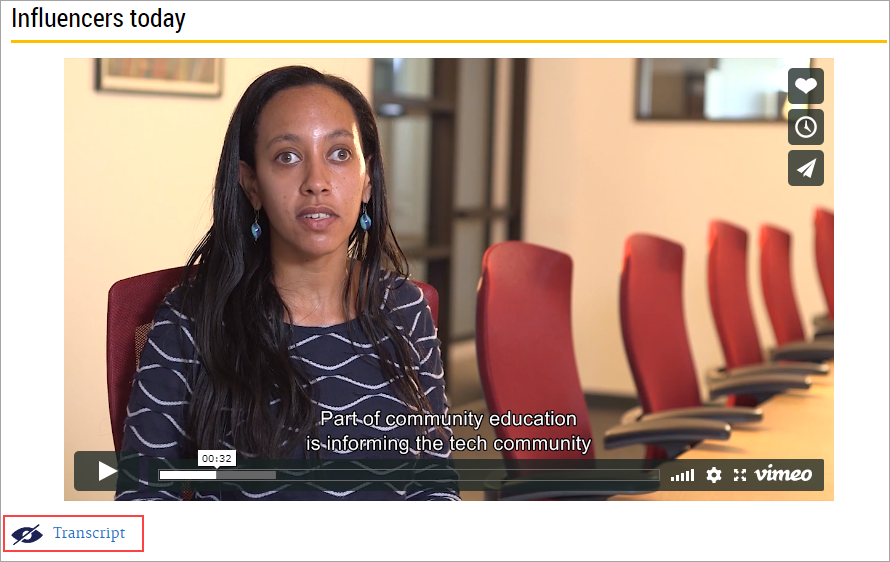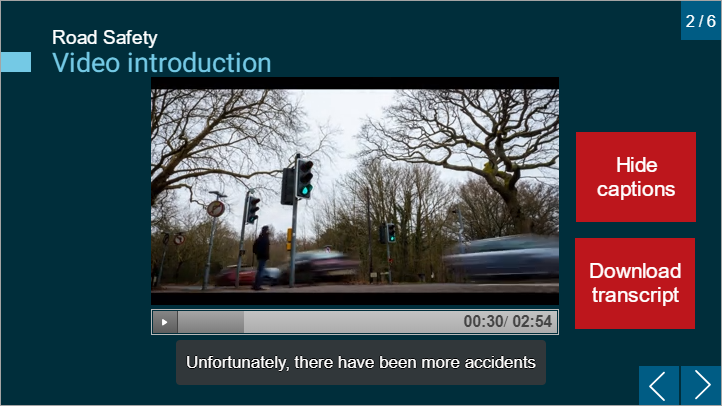For all videos with sound, either edit the audio track so that it includes audio description, or provide a descriptive transcript, a descriptive audio track, or the description in the surrounding text.
Note
If you need to meet Level AA standards for your eLearning resources, there is an additional AA standard – 1.2.5 Audio Description (Prerecorded) (Level AA) which refers to audio description. This standard says that you must provide audio description for videos, i.e. that it is not enough to provide just a transcript.
How do I comply?
Provide one of the following for any prerecorded videos with sound in your eLearning resource:
- Audio description
Edit the audio track for your videos, so that you can add audio description. This means that in the pauses in the dialogue, you can add description of any other relevant content. This could include the actions and expressions of characters, scene changes, background noises, laughter and off-screen voices etc.
Note
If the video is a “talking head” video i.e. it only contains one character speaking directly to the camera, it is unlikely that you will need to provide audio description. This is because there is no additional action or information which you need to describe. - Descriptive transcript
Add a transcript to your eLearning resource which is easy for the learner to find. It should include all words spoken in the video, as well as a description of any other relevant content such as the actions and expressions of characters, background noises, laughter and who is speaking etc. If the video has any interaction such as taking the learner to a web page with suplementary information then the transcript should provide the same functionality e.g. with a hyperlink. - Descriptive audio track
This would be an audio track which contains the same information as you would provide in a descriptive transcript. As with a descriptive transcript, it should also be easy for the learner to find. - Description in the surrounding text
If the video contains the same information that is already provided in the surrounding text, you do not need to provide a transcript, descriptive audio track, or audio description. This is because the text already provides the same information as the video conveys. It must be clear to learners that this is the case.
Why?
- Learners who are blind or have low vision will be able to hear the dialogue or narration in a video. They won’t be able to fully understand what is happening, however, without additional descriptive information such as who is speaking, what is taking place in the background etc.
- If you provide a descriptive transcript, someone who is blind or has low vision, can use a screen reader to read this out, or convert it to braille if they are deafblind.
- Transcripts can also be useful for learners with a cognitive impairment who may prefer to read rather than listen to content, or for second language learners.
eLaHub examples
1. Audio description
You can edit the audio track for your video to add audio description. This is done by adding any description in the pauses in the action or narration.
Microsoft Inclusive Design SME series featuring Haben Girma
Audio description
2. Descriptive transcript
Some tools will prompt you to automatically add a transcript for any videos e.g. CourseArc. Other tools allow you to manually add transcripts to your resource. It is up to you to make sure that the transcript is descriptive.

CourseArc
Video with transcript

Storyline
Video with transcript
How can I test?
Watch each of the videos in your eLearning resource then make sure that you can get the same information as a sighted learner by using one of the techniques described above.
Further information
Useful links
- WebAIM: guide to transcripts
A brief explanation of transcripts and why they are useful. -
UiAccess: Guide to transcripts on the Web
Provides best practice guidelines and information on creating transcripts. -
3Play Media: Ultimate guide to audio description
Comprehensive guide to everything you need to know about audio description. - 3Play Media: Intro to audio description webinar
Sign up to access this webinar. - WebAIM: Guide to audio description
A brief explanation of audio description. - University of Southampton: Accessible Audio-visual Media video explainer
Overview of captioning, transcripts, audio description, sign language etc.
WCAG information
| Category | Perceivable |
| Guideline | 1.2 Time based media Provide alternatives for time-based media |
| WCAG link | 1.2.3 Audio Description or Media Alternative (Prerecorded) (Level A) |
| WCAG text | An alternative for time-based media or audio description of the prerecorded video content is provided for synchronized media, except when the media is a media alternative for text and is clearly labeled as such. |
Copyright © [2020] World Wide Web Consortium, (MIT, ERCIM, Keio, Beihang)
Fully meet 1.2.3 Audio Description or Media Alternative (Prerecorded)
We only give a summary of the Level A standards on our site. Find out how to fully meet this standard in our book Designing Accessible Learning Content.



Recent Comments